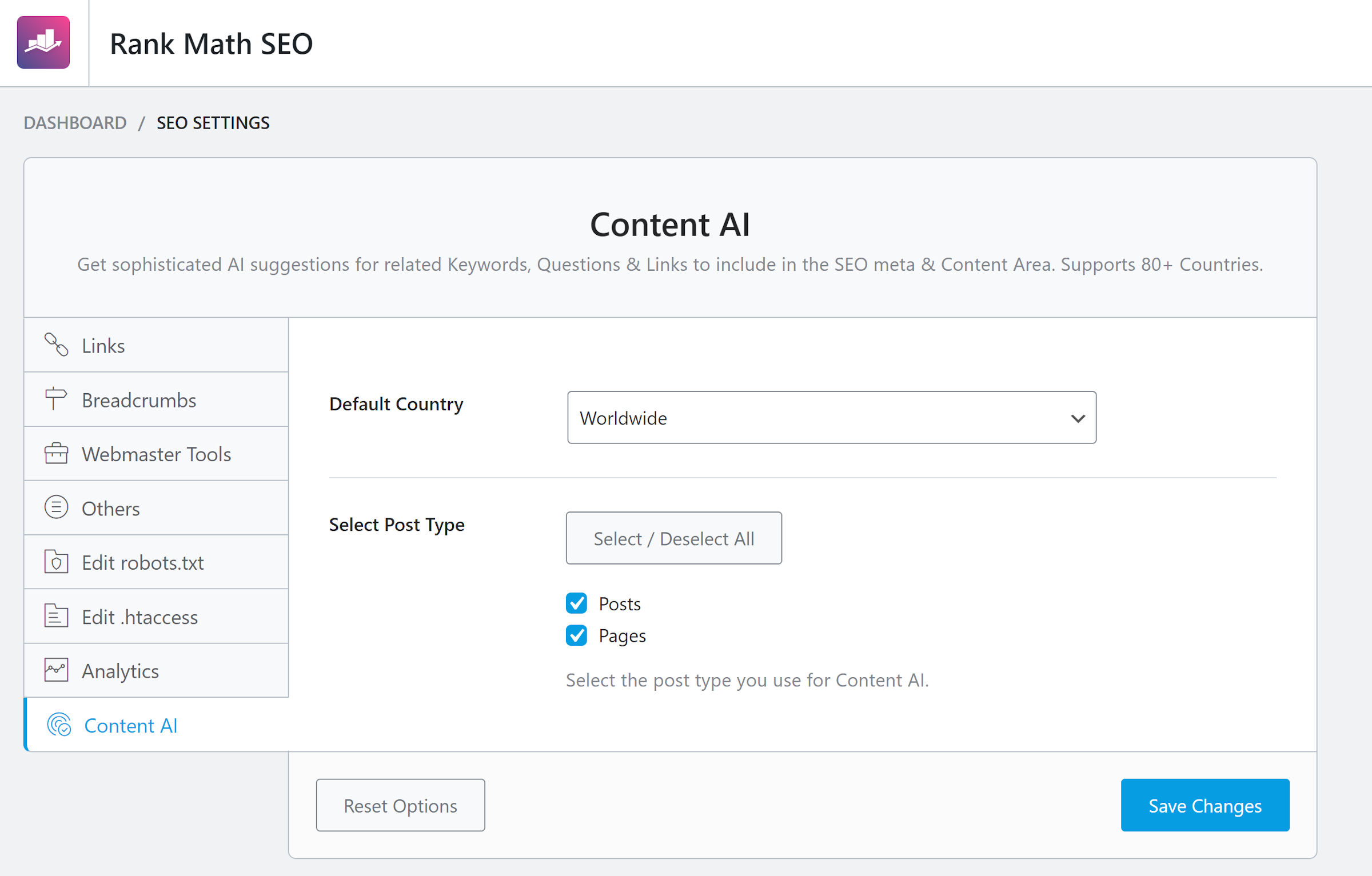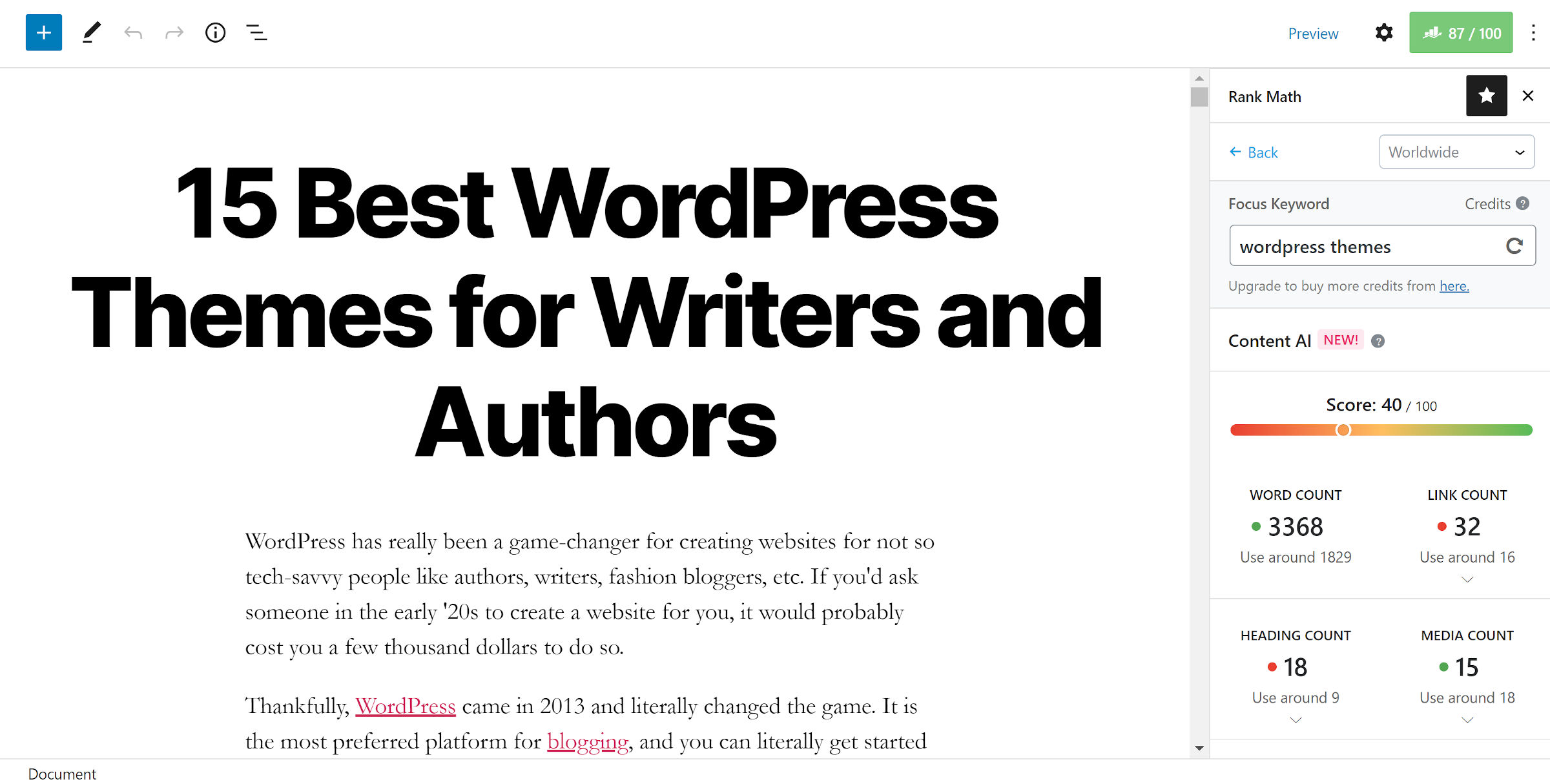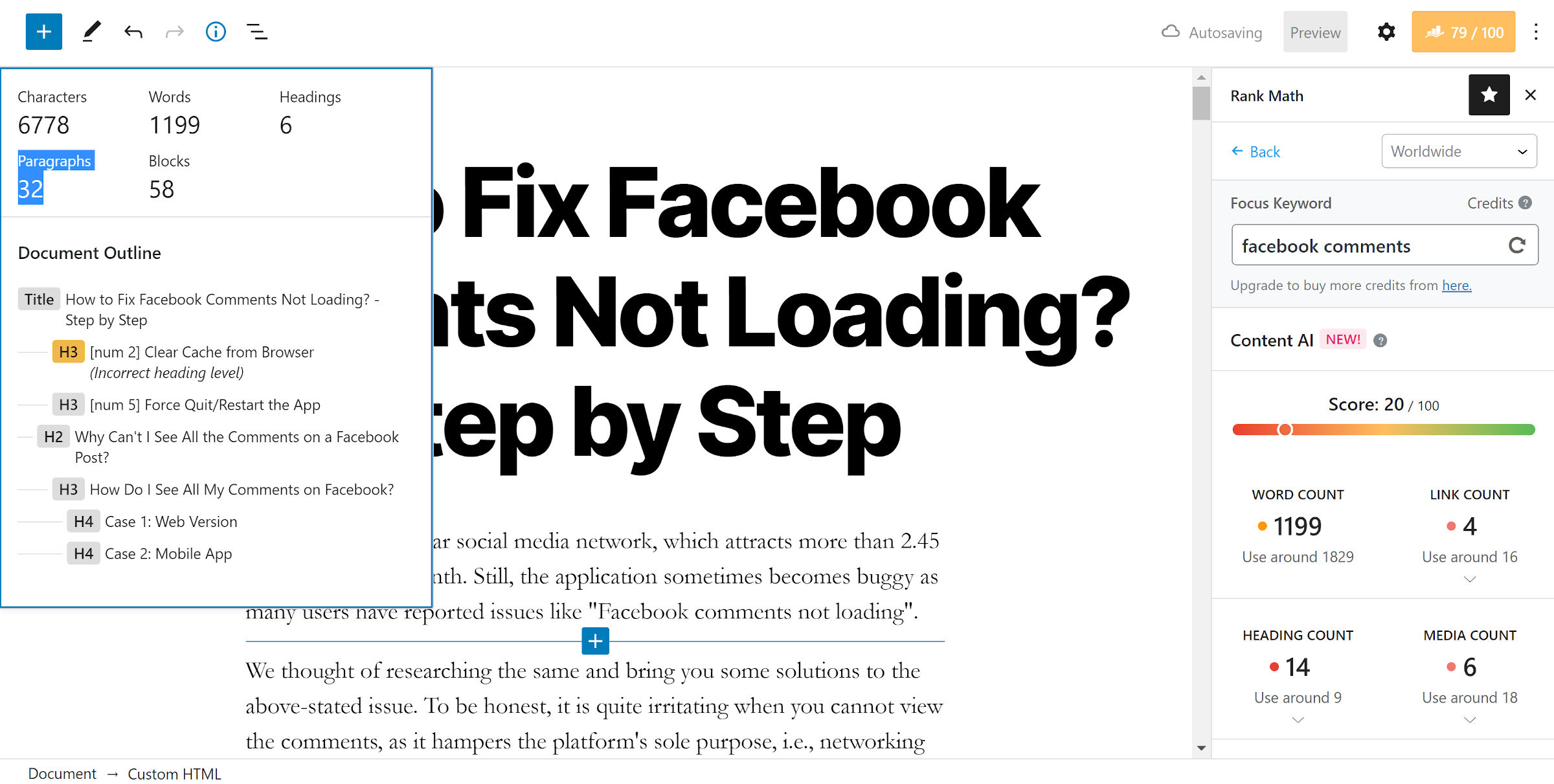Last week, the popular Rank Math SEO plugin received a major update that includes a new artificial intelligence system. The Content AI feature is a SaaS product that behaves like a personal writing assistant to boost search rankings.
“We built Rank Math’s Content AI feature to revolutionize the content production and optimization process with proprietary AI that gives SEOs and content marketers a competitive edge,” said Bhanu Ahluwalia, Rank Math’s CMO.
The system allows users to research what their content should look like based on a keyword. Each keyword analysis costs one credit. This data is stored on the user’s server, so the same keyword used on multiple posts does not cost extra. Users get five free credits after signing up for a user account with Rank Math. However, they must upgrade to one of the three commercial plans, ranging from $59 to $499 per year, for more.
Each of the commercial plans comes with a specific number of credits. They are marketed as free extras, but they are not “free” for users who want to upgrade for credits alone. The team says they are working on a pricing solution to address this.
Users should see a new Content AI module that they can enable from the plugin’s Dashboard screen. Turning this on creates a new tab under the plugin’s General Settings page for further configuration.

The Content AI feature works with the WordPress editor, the classic editor, Elementor, and Divi. However, the team plans to extend this support to other page builders in the future
Users can then enter a focus keyword from the post-editing screen and click the Content AI button. From there, they can research their chosen keyword, and Rank Math pulls up suggestions from their system.

The scoring system is easy to understand. Above 80 (in the green) is considered “good.” Anything below might need some work based on the plugin’s recommendations.
The primary suggestions from the Content AI center on total words, links, headings, and media. When asked how the numbers were figured, Ahluwalia said, “This is a computation performed based on the top-ranking content in search engine results pages (i.e., characteristics of content that ranks).” It is a proprietary system, so maybe the team is not ready to give away the exact details.
The feature also lets users copy related keywords to use in their posts, offers questions that the content should answer, and lists potential links to use.
The following video explains how Content AI works:
Are Content Scores a Good Thing?
I am admittedly skeptical of any claims from SEO tools. There is value in most of the plugins in the space, and Rank Math is no different. However, I also want end-users to take SEO or content scores with a grain of salt. Hitting a specific word, link, heading, or media count is not going to make or break you. These should be guidelines, not goalposts.
When asked how the score was calculated, I was pointed to a knowledgebase article on the Rank Math website. Nothing in the Content AI section explicitly explains the “math” behind the score. Essentially, the documentation references how the AI analyzes search results for various factors and describes how the tool works. There is some generally solid advice throughout, but it does not answer how those scores are calculated.
One particular area of concern was the recommended media count for each post. I had access to a full demo of the feature with a few dozen posts to check. Nearly all that I ran through the Content AI had a recommendation of using 18 media. The number felt off. While I cannot claim to be an SEO guru, I do not see why a typical 1,000 or 2,000-word post should need that many images or videos. Even with web-optimized media, that could bring page-loading speed to a crawl for many site visitors.
“That entirely depends on the focus keyword that you had set for your post,” said Ahluwalia on how the recommended count is determined. “Page speed is a ranking factor, but the media count and its associated guideline there is a super simple way to quickly see and consider whether that’s something that you need to do to rank as well. If we’re, for example, looking at the keyword ‘SEO tools,’ the recommendation is as high as 26, which is unsurprising because the majority of ranking content hasn’t just covered essential SEO tools, they’ve covered the 15, 20, or even 109 ‘best SEO tools.’
“This concern with using media in content as it relates to page speed is surprisingly common, but the reality is that content without design doesn’t typically perform particularly well (even if it ends up ranking, then not from a conversion/social sharing perspective because people leave with the impression of encountering a wall of text). A lot of the content on our site wouldn’t be the same without the images in the posts to paint the full picture and distill what are complex SEO processes/ideas into something that’s super simple for people to understand.”
I generally agree that sites should use media alongside text. Looking over one of the demo posts I had access to, the content did not seem to warrant the recommended count.
This particular post had 1,199 words and 32 paragraphs. It also had six images, which presumably played a significant role in the 20/100 score. Content AI recommended 18 instances of media.

Had the post met the recommended media count, there would have been one image for at least every two paragraphs. Even with half that number, visitors would unlikely think they are just “encountering a wall of text.”
Maybe the analysis is correct. Perhaps it will help sites rank. But, that much media mixed in with text strikes me as a sub-optimal reading experience.
My primary concern with tools like Content AI — this applies to SEO plugins in general — is that site owners are trying to make sure they are in the green. Instead of writing for readers, they are writing to rank. The two things are not mutually exclusive, but when end-users take recommendations as gospel, it can lead to stunted prose.
“We completely agree, and while AI content has come a long way, we’re very much also still fans of well-researched content that’s put together by humans like you and I (as is all of the content on our own blog),” said Ahluwalia. “The goal with Rank Math’s Content AI is assisted content production and optimization (streamlined by software).
“Broadly speaking, as you say, traffic-light style scores or numerical scores don’t paint a full picture for most content. This was a very big motivation for the new content optimization suggestions that go beyond typical scoring (that is the same no matter what you’re writing about). When writing something that isn’t search-driven at all (i.e. targeting a keyword and search intent that has little demand and no competition with a thought leadership piece, for example) you’re not writing for searchers, you’re writing for a specific set of people you have in mind. This content is still incredibly valuable though.”
He went on to say that for what the Rank Math team calls “search-driven” content, there are specific elements that well-ranking competing content has in common.
“It goes without saying that when using content optimization tools the consideration for still writing good content that’s helpful has to be there for the end result to be truly exceptional,” he said. “With the aim here being to aid the creation of content, ensuring it addresses search intent, and meets what search engines deem valuable and useful content.”
